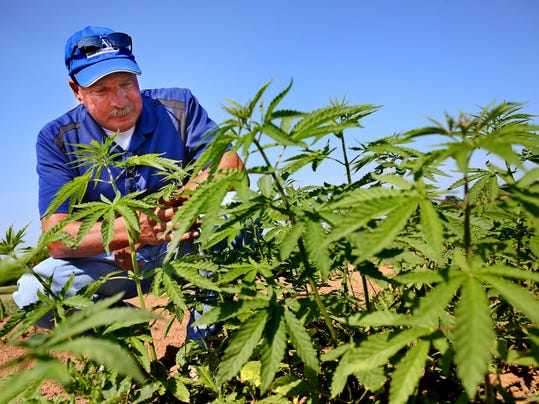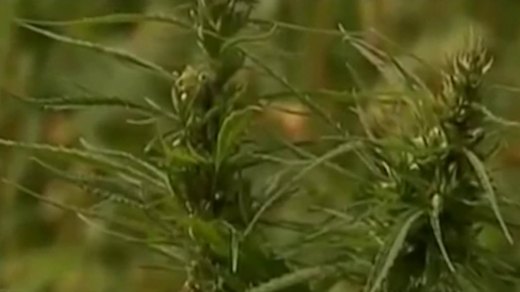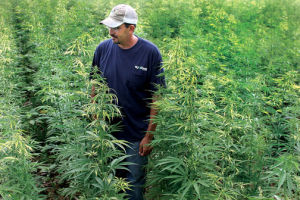By Gregory A. Hall
Source:
courier-journal.com
 (Photo: Alton Strupp/The Courier-Journal)
(Photo: Alton Strupp/The Courier-Journal)
LEXINGTON, Ky. – A month after the seeds for Kentucky's first legal hemp crop were released to the Kentucky Department of Agriculture, hundreds of leafy plants are growing in research fields across Kentucky.
After initial fears that government holdups on delivering the seed would limit growers' ability to get a good crop, seeds were released and planted around Memorial Day — beating a June 1 mark set by the Kentucky organizers of new trials to avoid significantly reduced yields.
Holly VonLuehrte, a spokeswoman for the state agriculture department said initial growing reports are good — shoulder high already in at least one location — and those assessments are echoed by two of the growers interviewed.
"The research will show that this is a crop that grows well in Kentucky, but particularly well out west at least thus far," VonLuehrte said. "All indications are it's not just doing well," it's doing "extremely well."
"Hemp certainly grows well in Kentucky's climate, Kentucky's soil types," said Katie Moyer of the Kentucky for Hemp group, and who is growing the plant in Christian County. "We're seeing that it works really well for erosion."
Politically, the crop that has been in the ground for a month has been years in the making politically.
Kentucky's legislature passed a law in 2013 sought by Agriculture Commissioner James Comer and U.S. Sen. Rand Paul, R-Ky., to make the state among the first to grow industrial hemp if federal law — which treated hemp like its more potent cousin, marijuana — ever allowed it.
Then Congress passed this year's Farm Bill, allowing states that have passed such laws to conduct pilot programs through their agriculture departments and universities.
The Kentucky agricultural department's main seed shipment was then detained by federal officials at Louisville International Airport for more than a week.
The state sued the U.S. government in federal court to get the shipment released, saying potential yields from the hemp seeds already had been hurt by the delay and planting beyond June 1 could result in a crop that wouldn't produce meaningful research results.
The Kentucky department ultimately registered and received a permit from the Drug Enforcement Administration so the shipment could be delivered. VonLuehrte said a procedure is nearly developed and the case — which is still pending — might be dismissed.
"I think we're going to settle our case because we will have gotten everything we wanted," she said. "We've got a process with the DEA that's in place now and we're very, very close to an agreement on a standard process that we will use every time we need to import."
The department also is getting a nearly 900-pound seed shipment from Canada for a handful growers who want to proceed this year even though it is later in the growing season, VonLuehrte said.
Now that the crop is in the field, the issue will become what to do with what's grown when it's harvested.
VonLuehrte said the universities have received inquiries from processors who would like the hemp, while at least one grower has a buyer. The department has to review any sales contract, she said.
Plots in Christian County being grown by Moyer will be bought by Wisconsin businessman Ken Anderson, who is a distributor for Italian hemp seeds being used in Kentucky and for businesses that use the finished product.
Kentucky's hemp could be used to make concrete for construction and highway sound barriers, automotive matting and insulation for homes.
By virtue of helping bring in the Italian seed, Anderson said he gets to buy any of the hemp grown from those seeds or must approve any other sales. He's hoping to get it all, if the state agriculture department allows the universities involved in those projects to sell the plants.
"We want every plant that's grown," he said in a telephone interview. "I could use all of that and about a thousand times more."
Anderson said he already plans to pay Moyer "fair market value" for the plants based on the Canadian market.
Moyer's crop, planted more than three weeks ago, is now a little more than a foot high.
A hemp field at the University of Kentucky was planted May 27.
UK turfgrass researcher David Williams, who is helping oversee the project, said the harvest likely will be in October, just after the first killing frost. It also will depend on the plants' maturity, he said.
Since the UK seeds came from Italy, which is more Mediterranean in climate, Williams said, "We don't know how well they'll perform here. So far, it's fine."
Williams said that UK researchers originally planned to do a trial where small hemp plants would be grown in small containers like tobacco and then transplanted to the ground — but because of the delay in the seed delivery, they decided just to drill it into a field on UK's farm near the Kentucky Horse Park.
The field is visible from the nearby highway, Iron Works Pike, but the plants currently are dwarfed by nearby miscanthus.
Williams said part of the UK crop will be treated with herbicide — though he doubts it will need it — to see how the plant handles it. The herbicide would be experimental since he said no products are specifically designed for hemp. The three major pests it faces are fungi, insects and weeds, he said.
Now, it's a matter of monitoring its growth until the harvest.
Williams said his almost 90-year-old father-in-law grew hemp when it was allowed and laughs now at how it was harvested by hand then — with seed harvesting being a two-man job where one person held as many plants as possible and the other beat them with a tobacco stick to shake off the seeds. Williams said mechanized equipment now can cut and bale and combines harvest only the seed.
But, back then, it was "horribly labor intensive to harvest," Williams said, adding his father-in-law "does not have fond memories — but he does remember it."











